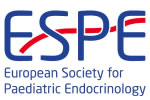hrp0086p2-p405 | Gonads & DSD P2 | ESPE2016
Maternal Ovarian Luteoma Causing Complete Virilization of a Female Fetus
Davis Vanessa , Minutti Carla Z
hrp0095p2-178 | Growth and Syndromes | ESPE2022
A Rare Cause of Proteinuria Presenting with Short Stature, Cataract, and Dysmorphic Findings: Lowe Syndrome with A Novel de Novo Mutation in the OCRL1 Gene
Gürbüz Fatih , Bilginer Gürbüz Berrak , Özalp Yüreğir Özge , Çayır Atilla
ea0050ep045 | Clinical Biochemistry | SFEBES2017
A curious case of recurrent episodes of multiple-electrolytes derangement
Htun Kyaw Z , Rajkanna Jeyanthy , Sagi Satyanarayana V , Oyibo Samson O
hrp0095p2-20 | Adrenals and HPA Axis | ESPE2022
Autoimmune Polyglandular Syndrome Type 2: Two Different Applications
Derya Bulus Ayse , Yasartekin Yuksel , İnözü Mihriban
hrp0098p2-63 | Diabetes and Insulin | ESPE2024
The frequency of anemia and the evaluation of related factors in patients with type 1 diabetes mellitus
Gönen Melih , Deniz Papatya Çakir Esra , Gördü Zülfikar
hrp0098p3-118 | Fetal, Neonatal Endocrinology and Metabolism | ESPE2024
A retrospectıve evaluatıon of pedıatrıc patıents admıtted wıth hypoglycemıa ın terms of etıology
Alagöz Gülsara , Deniz Papatya Çakir Esra , Ersoy Melike
hrp0092p1-404 | Pituitary, Neuroendocrinology and Puberty (2) | ESPE2019
Improvement of Final Height in Idiopathic Central Precocious Puberty is Associated with Delay of Bone Maturation with GnRH Agonist Therapy Under the Age of 7 Years
Vuralli Dogus , Gonc E. Nazli , Ozon Z. Alev , Kandemir Nurgun , Alikasifoglu Ayfer
hrp0092p2-223 | Pituitary, Neuroendocrinology and Puberty | ESPE2019
Long Term Effects of GnRH Agonist Therapy on BMI in Girls with Idiopathic Central Precocious Puberty
Vuralli Dogus , Ozon Z. Alev , Gonc E. Nazli , Alikasifoglu Ayfer , Kandemir Nurgun
hrp0092p2-224 | Pituitary, Neuroendocrinology and Puberty | ESPE2019
To Whom Should Central Nervous System Imaging be Performed in Girls with Central Precocious Puberty (CPP)?
Vuralli Dogus , Gonc E. Nazli , Alikasifoglu Ayfer , Kandemir Nurgun , Ozon Z. Alev
hrp0082p3-d2-824 | Growth (1) | ESPE2014
GH Deficiency in a Case with Neurofibromatosis-Noonan Syndrome
Vuralli Dogus , Gonc E Nazli , Vidaud Dominique , Ozon Z Alev , Alikasifoglu Ayfer , Kandemir Nurgun



